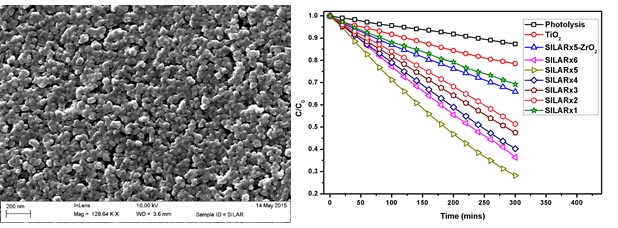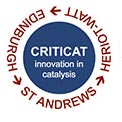Another way in which we may take advantage of the suns energy is to use it to power chemical reactions. For this purpose, the most commonly applied material is titanium dioxide (TiO2) which has gained much success due to its stability, non-toxicity and low cost. However, the activity of TiO2 is limited to only the UV component of the solar spectrum, and as such we aim to improve photocatalytic efficiencies by sensitisation of TiO2 to the visible portion of sunlight. We take advantage of the groups facilities and experience in fabricating high surface area mesoporous films of TiO2 to which we can apply simple sensitisation techniques to create immobilised photocatalytic films with activity to the abundant visible portion of the solar spectrum.
Our work on this theme is split into two areas: the use of bulk inorganic materials such as oxides and sulphides to degrade organic pollutants in potential drinking water sources, and the combination of photocatalytic hydrogen production with hydrogenation of molecular substrates.
Photocatalytic Water Purification: The availability of clean drinking water is key in providing long term health security to the global population. Semiconductor photocatalysis has arisen as a potential method to destroy organic pollutants and bacteria through the photocatalytic generation of highly oxidising species. Our work focuses upon combining TiO2 with other narrower band gap semiconductors to generate composite materials with high activity under visible light irradiation.

Figure 1. An SEM image of the surface of a TiO2 film (Left), photocatalytic degradation of a model dye compound by different sensitised TiO2 films under visible light (Right).
H2 Production/Hydrogenation: We are also currently working on the development of a novel catalytic system with the ability to catalyse hydrogenation reactions in water using low energy, abundant visible light. Hydrogenation is one of the most important and widely utilised transformations, especially in industry where it is used for applications ranging from pharmaceuticals to fine chemicals. The new system will combine sophisticated molecular transfer hydrogenation catalysts with heterogeneous TiO2 supports with the aim of utilising the best aspects of both systems.
Both of these projects are undertaken with support and training from the CRITICAT Centre for Doctoral Training in Critical Resource Catalysis.


